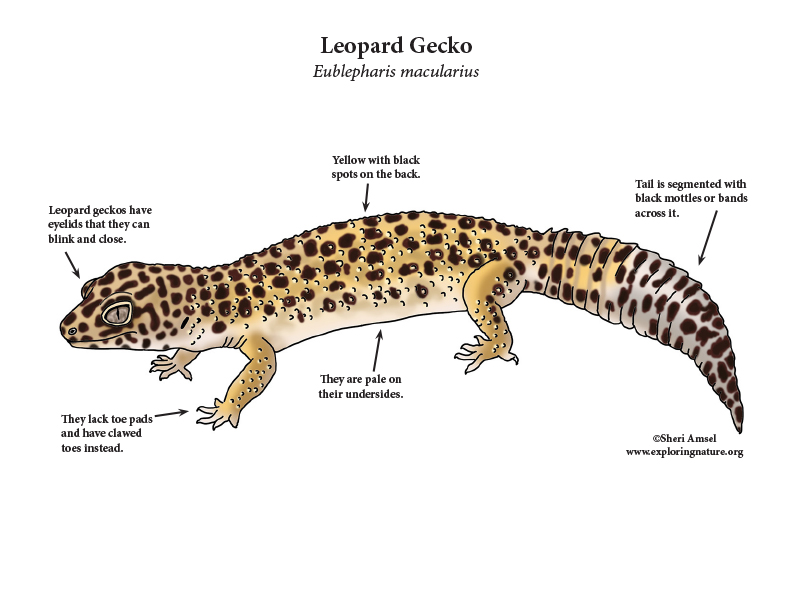

They are found Asia, Northern India, Afghanistan, Pakistan, Iran and Iraq, but were imported into the US by the pet trade in the 1990s. They are thought to be the common pet lizard today.
They live rocky desert habitats.
Male leopard geckos are bigger than the females reaching at most up to 11 inches (28cm) - but are usually smaller. Females can reach 8 inches (20 cm), but are usually smaller. In the wild, they vary in color from pale to deep yellow with black spots on the back. The tail is segmented with black mottles or bands across it. They are pale on their undersides. In captivity, breeders have produced a whole range of colors, so that pet geckos can be blue to purple. Like many small lizards, they can lose their tails and grow them back. Regenerated tails, however, do not come back looking like the original. Leopard geckos have eyelids that they can blink and close (many gecko species cannot). They have a long tongue with which they can snatch prey. They also use it to moisten eyes.
Leopard geckos are active in the morning and evening hours (corporeal) when the temperatures in their desert habitat are not too extreme. They can be active at night in more mild temperatures. During the extreme heat of day or cold of night, they rest under rocks or in burrows underground. They shed their skin periodically. They do not climb smooth surfaces, like some gecko species, because they lack toe pads and have clawed toes instead. They are known to shake their tails to communicate courtship or other signals - such as preparing to attack prey. They can also make a chirping sound and even a “bark” when they feel threatened. Leopard geckos generally are found alone, but females may group together.
They eat insects (adult crickets and grasshoppers, larvae, etc.), spiders and other invertebrates (centipedes, etc.) and even mice nestlings. They get the moisture they need from their prey and do not often need to drink water.
They are preyed upon by snakes, larger lizards, hawks and foxes.
Females lay two eggs and they incubate for 6-7 weeks before hatching. She may breed several times each season. Scientists have discovered that the sex of hatching young depends on the temperature. The hotter temperature incubations (90°F 32°C and above) produce more males.
They can live more than 20 years in captivity.
Kingdom: Animalia
Phylum: Chordata
Class: Reptilia
Order: Squamata
Family: Eublepharidae
Genus: Eublepharis
Species: E. macularius
When you research information you must cite the reference. Citing for websites is different from citing from books, magazines and periodicals. The style of citing shown here is from the MLA Style Citations (Modern Language Association).
When citing a WEBSITE the general format is as follows.
Author Last Name, First Name(s). "Title: Subtitle of Part of Web Page, if appropriate." Title: Subtitle: Section of Page if appropriate. Sponsoring/Publishing Agency, If Given. Additional significant descriptive information. Date of Electronic Publication or other Date, such as Last Updated. Day Month Year of access < URL >.
Amsel, Sheri. "Gecko (Leopard)" Exploring Nature Educational Resource ©2005-2024. December 13, 2024
< http://exploringnature.org/db/view/5901 >

